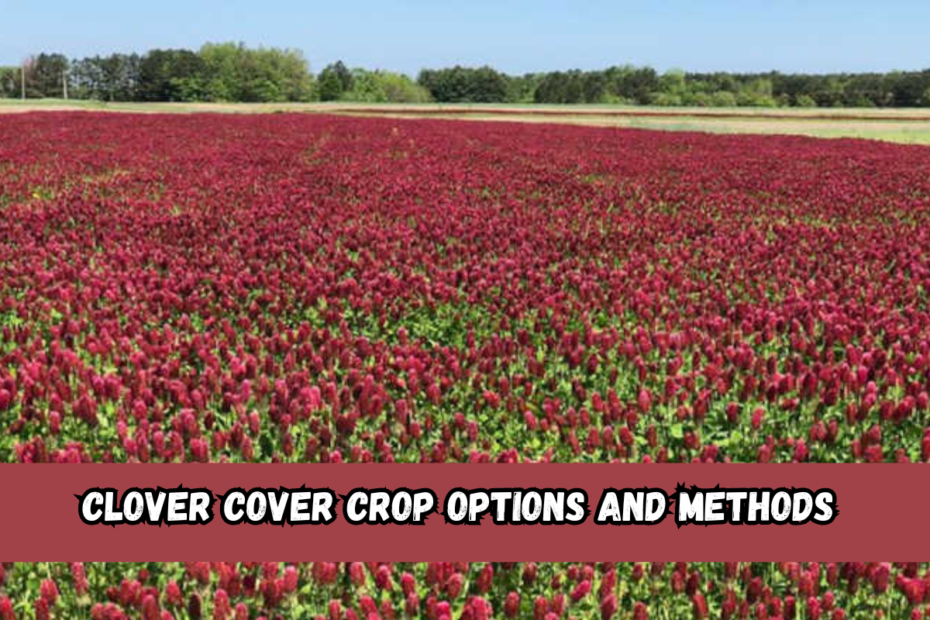Clover Cover Crop Options And Methods:- Due to the multiple benefits that clover offers for soil health, weed reduction, and overall biodiversity, it is a popular choice for cover cropping. This method is an efficient approach of enhancing the structure of the soil, boosting fertility
Clover Cover Crop Options And Methods
Promoting ecological balance in agricultural settings such as gardens and farms. Gaining an understanding of the numerous species of clover and the characteristics that distinguish them will assist growers in selecting the solutions that are best suited to meet their requirements.
ALSO SEE : Can Hostas Take Full Sun? Or Do They Need Partial to Full Shade?
Integrating Clover into Crop Rotations
Clover, when used into crop rotation systems, not only improves the fertility and structure of the soil, but it also breaks the cycles of pest growth.
Farmers are able to take use of clover’s nitrogen-fixing qualities and contribute to an overall improvement in the health of the soil by alternating it with income crops. This rotating strategy helps to foster a more resilient ecosystem and provides support for farming technique.
Intercropping with Clover
It is possible to successfully intercrop clover with other, more important crops, which will allow for simultaneous growth. This approach maximizes the usage of land while also increasing total output. Using clover as an intercrop helps to lessen competition for resources since clover,
which grows at a low height, frequently complements crops that grow at a higher height. In addition, the presence of clover can enhance the soil’s ability to retain moisture and lower the amount of pressure exerted by weeds.
Seasonal Cover Crop Strategy
Clover has the potential to be used as a cover crop during the fall season, when it is sown to protect the soil from the harsh winter months. By taking this technique, erosion can be avoided, and the health of the soil can be preserved after periods of inactivity.
Clover could be cut down in the springtime so that it can continue to supply nutrients to succeeding crops. In addition to enhancing the quality of the soil, this method also contributes to the enhancement of the farming system’s overall sustainability.
No-Till and Conservation Tillage Systems
Clover can serve as a live mulch in systems that do not require tilling the soil. Farmers are able to maintain soil cover and moisture levels without changing the structure of the soil if they sow clover alongside income crops.
In addition to delivering the advantages of nitrogen fixation, this technique improves the health of the soil by encouraging the activity of microorganisms and reducing the amount of erosion that occurs.
Timing and Planting Considerations
The timing of the planting of clover as a cover crop is quite important. The growth cycles and environmental preferences of various species are extremely distinct from one another.
Making sure that clover is planted at the right time ensures that it will establish itself properly and will be able to successfully contribute to the health of the soil.
In areas with cooler weather, the best time to plant is typically early spring or fall, but warmer places may have the ability to plant throughout the entire year.
Soil Types and Conditions
In addition, the kind of soil and the conditions might play a role in the selection of clover species. As an illustration, deep-rooted types such as red clover perform exceptionally well in soils that are heavier.
whereas shallow-rooted species such as white clover may be better suited for soils that are lighter and have greater drainage.
It is helpful to have an understanding of the local soil qualities in order to select the appropriate clover variety in order to make the most of its benefits.
Challenges and Considerations
Although clover requires little upkeep in general, there are certain difficulties that may occur. A number of diseases and pests have the potential to harm clover, particularly if the conditions are not ideal.
Regular monitoring is necessary in order to resolve any problems as soon as they arise. In addition, it is essential to have a thorough awareness of the potential rivalry that clover may have with primary crops in order to guarantee that clover will not impede the growth of plants that are wanted.
